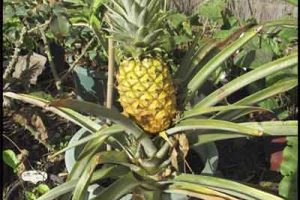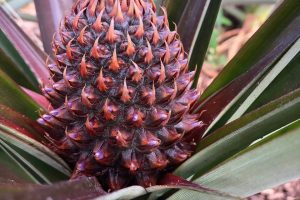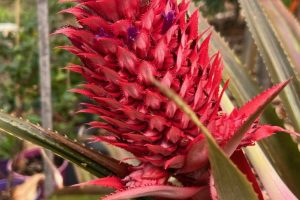Ananas comosis
Pineapple
Origin
The centre of origin was in the Americas within 10 degrees of the Equator. Nowadays it is grown in almost all tropical and subtropical areas of the world and production ranks 3rd behind bananas and citrus.
Climate
Ideal precipitation is 1000-1500mm evenly distributed throughout the year. It has xerophytic characteristics allowing for resistance to drought, but production will be impaired. Temperature is also very important, with ideals of 29 and 32°C for root and leaf growth respectively; below 18-20°C both almost stop. There is no tolerance of frost.
Plant Description
It is a monocotyledonous perennial herb with a short stem, 30-35cm long, from which a spiral rosette of strap-like smooth and waxy leaves develops, up to 1m long, Different varieties have variable numbers of spines on leaf margins. The root system is fibrous and shallow.
Relatives
Bromeliaceae Family. It is the only species in the Family grown commercially for its fruit.
Soils
Provided there is good drainage it is undemanding, with a preference for a sandy or well-aggregated clay soil, pH 4.5-5.
Propogation
Various parts of the plant are propagated vegetatively, principally using crowns and slips (shoots from the base of the plant). These are first dried for a few days before planting. The 4 distinct classes worldwide are Smooth Cayenne (SC), Queen (Q), Red Spanish and Abacaxi. The first two are the main ones seen in Australia and each of these has a number of local selections which may be sourced in WA. Very rarely, seeds may be found in a pineapple, usually the result of cross pollination. They are small, hard and black or brown, located behind each ‘eye’. They germinate readily but the tiny succulent plants are very vulnerable to slugs and snails.
Flowering and Pollination
Inflorescences are produced at the stem apex and may have 100-200 individual purple or red hermaphrodite flowers. Each flower is accompanied by a yellow-green bract and consists of 3 sepals, 3 petals, 6 stamens and a tricarpellate ovary. Cool night temperatures together with shortened day length stimulates flower induction. Pineapples are self-incompatible and seedless fruit develop parthenocarpically.
Cultivation
Fruit size is correlated with average sunlight received from planting to harvest, but intense sunlight can cause scalding of fruit. Irrigation will be necessary during dry periods. Plants have a high requirement for N and K but low for P, and they respond well to foliar fertilization. Trace element deficiencies can occur, particularly on alkaline soils. They can be grown in pots.
Wind Tolerance
Reasonable
Pruning
The only pruning is when slips are required for the next generation of plants.
The Fruit
The fruit is a syncarp of fused fruitlets of inferior ovaries together with the bracts and the central stem which becomes the core. The skin is tough and leathery, initially green and yellow-red at maturity. The core is fibrous but edible. The succulent and juicy flesh is white to yellow and sometimes red. The sugar to acid ratio depends on the cultivar and temperature during development; higher temperatures increase this ratio. Pineapples contain about 13% carbohydrates.
Fruit Production and Harvesting
Crowns and slips may take 18-24 and 15-20 months from planting to harvest respectively. Fruit maturity is judged mainly by skin yellowing; they are non-climacteric. They can be stored at 8°C and high humidity for 4-6 weeks; lower temperatures cause chill injury resulting in blackish flesh .
Fruit Uses
The major use commercially is canning and juice preparation. Home growers usually eat them fresh, with the Q type often preferred as they are crisper and more reliably sweet. In subtropical areas the SC types may be quite acid in Winter.
Pests and Diseases
The most likely problems are mealy bugs and nematodes, the latter particularly so in sandy soils. Controlling ants will help reduce the mealy bug risk. Cool and damp conditions increase fungal rots.
Comments
The climate in Perth and surrounds is some way from being ideal for growing pineapples but they can produce here. Propagating material (crowns) can be obtained from retail fruit where the tops have not been removed.


